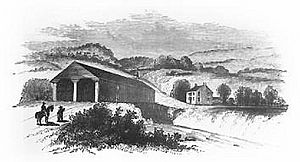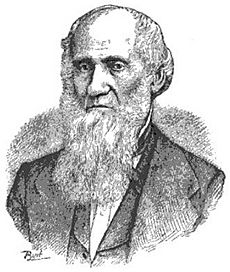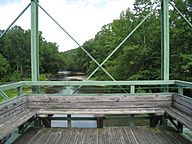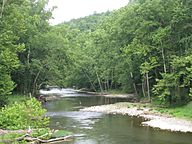Capon Lake Whipple Truss Bridge facts for kids
The Capon Lake Whipple Truss Bridge is a special historic bridge in Capon Lake, West Virginia. It's also known as the South Branch Bridge or Romney Bridge. This unique bridge uses a design called a Whipple truss. It crosses the Cacapon River and is located near West Virginia Route 259.
This bridge is super important because it's the oldest Whipple truss bridge still standing in West Virginia. It's also the oldest metal truss bridge in the state! Its design shows off amazing engineering ideas from the 1800s.
Quick facts for kids Capon Lake Whipple Truss Bridge |
|
|---|---|

Capon Lake Whipple Truss Bridge, looking northwest from its southeast end, in 2009
|
|
| Coordinates | 39°09′30″N 78°32′7″W / 39.15833°N 78.53528°W |
| Carries | |
| Crosses | South Branch Potomac River (1874–1937) Cacapon River (1938–present) |
| Locale | Hampshire, West Virginia, United States |
| Official name | Capon Lake Whipple Truss Bridge |
| Other name(s) | South Branch Bridge, Romney Bridge |
| Named for | Capon Lake |
| Maintained by | West Virginia Division of Highways, District 5 |
| NRHP # | 11000929 |
| Characteristics | |
| Design | National Register of Historic Places |
| Total length | 176 ft (54 m) |
| Width | 20 ft (6.1 m) |
| Height | 23 ft (7.0 m) |
| History | |
| Constructed by | T. B. White and Sons |
| Rebuilt | 1938 |
| NRHP reference No. | 11000929 |
| Added to NRHP | December 15, 2011 |
This bridge wasn't always in Capon Lake. It was first built in 1874 near Romney, West Virginia. Back then, it was part of a bigger bridge that carried a major road. In 1937, it was taken apart and moved to its current spot. This shows how clever engineers were, making bridges that could be moved!
Today, the Capon Lake Whipple Truss Bridge is a special place. It's no longer used for cars. Instead, it's a pedestrian bridge where people can walk and enjoy the views. It was added to the National Register of Historic Places in 2011.
Contents
Where the Bridge is Located
The Capon Lake Whipple Truss Bridge is in a beautiful, mostly rural area. It's in the southeastern part of Hampshire County, West Virginia. The bridge sits in the valley of the Cacapon River.
To the west, you can see Baker Mountain. To the east, the Great North Mountain rises. Just north of the bridge, the Capon Springs Run flows into the Cacapon River. The George Washington National Forest is also nearby.
The bridge is along Carpers Pike, which is West Virginia Route 259. It's in the small community of Capon Lake, West Virginia. The historic Capon Springs Resort is about 3.5 miles east. A newer bridge was built in 1991 to carry car traffic. This allowed the old Whipple truss bridge to be saved for people to enjoy.
How the Bridge is Built
The Capon Lake Whipple Truss Bridge is a great example of early metal truss bridge technology. This type of building method was very important for highway bridges for many years. Because of its unique design and age, it's one of West Virginia's most important historic bridges.
The bridge is about 20 feet wide and 176 feet long. It rests on a strong concrete base. The main part of the bridge, called the truss structure, has a special "double-intersection" design. It's made of 14 sections, each about 11 feet wide and 23 feet high. The bridge is built from wrought iron pieces connected with pins.
Today, there's a wooden walkway along the entire length of the bridge. It even has a special observation deck and wooden seats in the middle. This is a perfect spot to relax and look out over the river.
The Bridge's History
How the Whipple Truss Was Invented
The Whipple truss design was created in 1847 by an engineer named Squire Whipple. He was one of the first engineers to use science and math to figure out how forces and stresses affect bridges. His book, A Work on Bridge Building, changed how bridges were designed forever.
Whipple's design added "double-intersection diagonals" to the standard Pratt truss. This meant the diagonal parts of the bridge could cross two sections instead of just one. Later, in 1859, another engineer named J. W. Murphy improved Whipple's design. He created the first truss bridge that used pinned eyebar connections. This made it easier to build truss bridges without needing lots of rivets.
The Capon Lake bridge uses both Whipple's and Murphy's ideas. That's why it's called a Whipple–Murphy truss bridge. These new ideas, along with better ways to make steel and iron, made metal truss bridges very popular in the United States.
Back then, counties could order metal truss bridges from catalogs. They would give the size and other details, and the parts would be shipped to the building site. Local teams would then put them together. Metal bridges were cheaper, could span longer distances, and were stronger than wooden bridges. They could also be taken apart and moved, which was a big deal!
The Original South Branch Bridge

The Capon Lake Whipple Truss Bridge was first built in 1874. It was part of a larger, two-span bridge called the South Branch Bridge (or Romney Bridge). This bridge carried the Northwestern Turnpike (U.S. Route 50) across the South Branch Potomac River near Romney.
This 1874 bridge replaced an older wooden covered bridge from 1838. That wooden bridge was destroyed during the American Civil War. The area around Romney was very important during the war. The bridge crossing changed hands many times between the Confederate and Union armies.
After the war, many bridges were destroyed. People in Hampshire County wanted new bridges built quickly to help businesses. So, in 1874, the T. B. White and Sons company built the new Whipple truss bridge. It was a "complete, handsome and durable structure."

The Whipple truss bridge served travelers for 63 years. In 1935, plans were made to replace it. In 1936, a car accident damaged one part of the bridge, causing it to collapse. A temporary wooden bridge was put in place until the new bridge was finished in 1937.
The Bridge Moves to Capon Lake
Since Whipple truss bridges could be easily taken apart, the remaining part of the old South Branch Bridge was moved. In 1937, it was taken down and brought to Capon Lake. It was rebuilt there in 1938 to carry Capon Springs Road over the Cacapon River. Before this, people had to use a swinging footbridge or wade across the river!
Workers built new concrete supports for the bridge by hand. The newly rebuilt Capon Lake Bridge was officially opened on August 20, 1938. There was a big ceremony with music and important state officials, including former West Virginia Governor Herman G. Kump.
In 1991, a new bridge was built nearby for cars. This meant the Capon Lake Whipple Truss Bridge could be closed to vehicle traffic. Because it was so rare and important, the West Virginia Division of Highways decided to save it. They removed the old roadway and added the wooden pedestrian walkway and observation deck you see today.
The Capon Lake Whipple Truss Bridge was added to the National Register of Historic Places in 2011. It's recognized for its "engineering significance as an excellent example of a Whipple/Murphy Truss bridge." Today, it's a historic site for everyone to visit and enjoy. A historical marker was even placed at the bridge in 2012, telling its amazing story.






